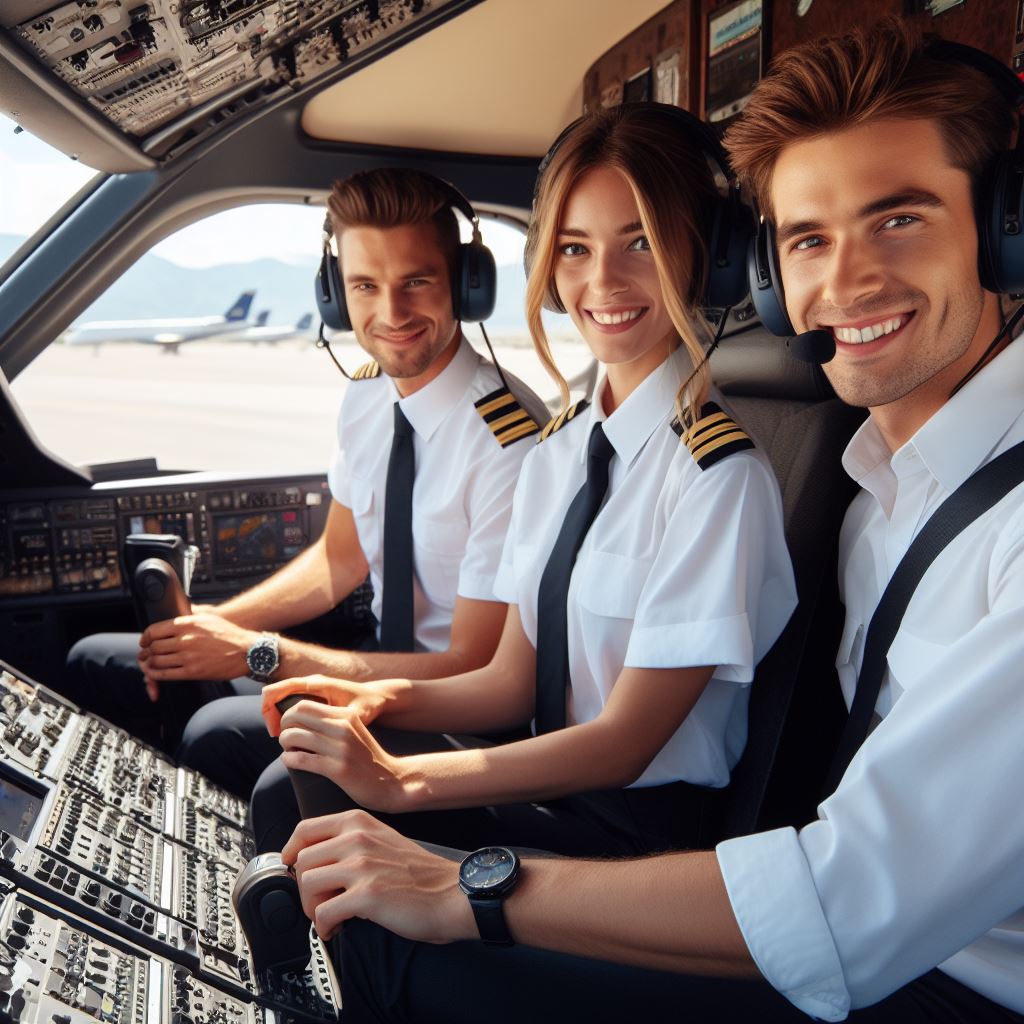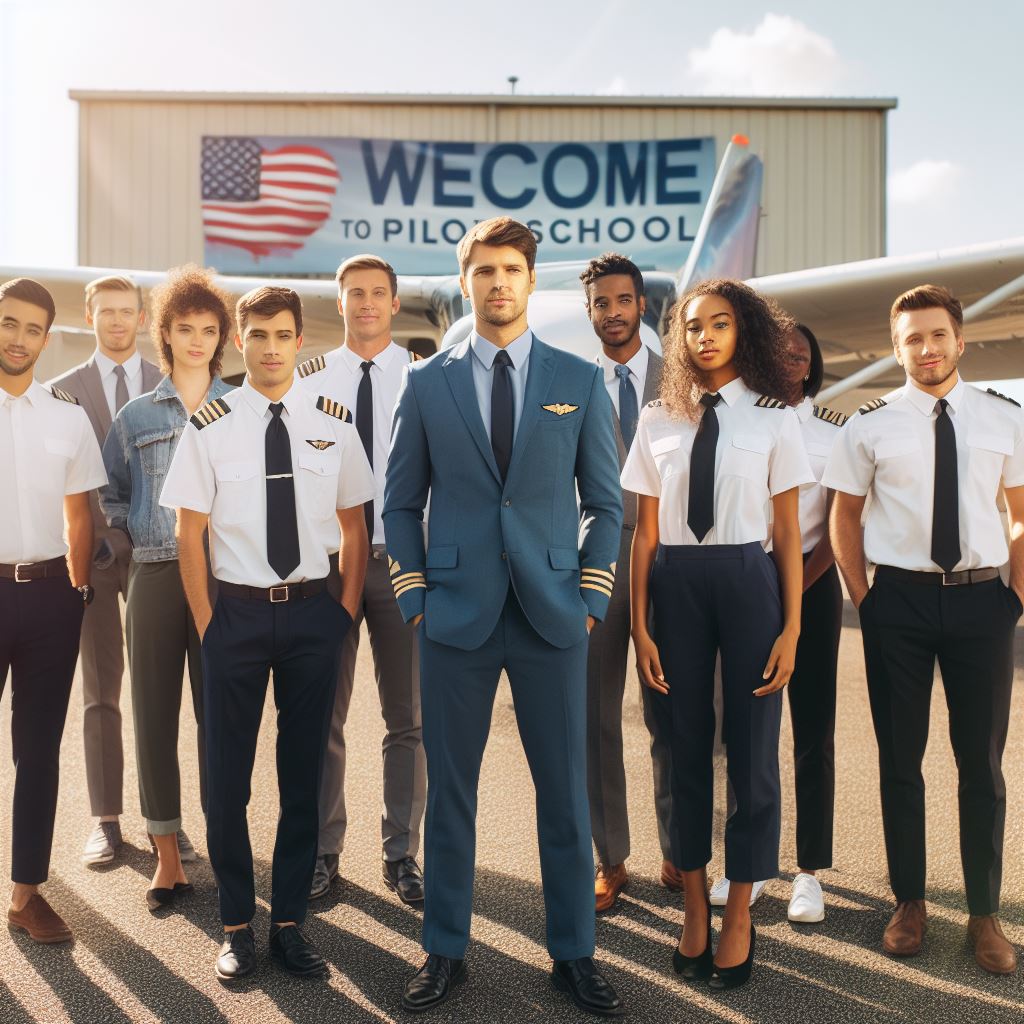Introduction
Becoming a commercial pilot holds immense significance as it offers an exciting and fulfilling career.
Firstly, commercial pilots play a pivotal role in ensuring global connectivity by transporting passengers and cargo, fostering economic growth and international relations.
Secondly, the rigorous training and certification process instill a high level of discipline, responsibility, and problem-solving skills in individuals, contributing to personal development.
The job’s demanding nature hones decision-making abilities and crisis management skills, preparing pilots to handle complex situations under pressure.
Moreover, commercial pilots often experience diverse cultures and environments, fostering a global perspective.
Financially, the profession offers competitive salaries and benefits, making it an attractive career option.
Overall, the role of a commercial pilot extends beyond the cockpit, influencing both personal growth and contributing significantly to the functioning of the globalized world.
The purpose of this blog post is to provide a comprehensive guide on the path to becoming a commercial pilot in the USA.
A career as a commercial pilot appeals to many due to the allure of flying, the sense of adventure, and the opportunity to travel to different destinations.
Overview of the Commercial Pilot Career
Definition of what a commercial pilot does and their responsibilities
A commercial pilot is a professional aviator who is licensed to operate aircraft for financial gain.
The responsibilities of a commercial pilot include ensuring the safety of passengers and cargo during flights.
Different types of commercial pilots
There are various types of commercial pilots, including airline pilots, corporate pilots, and cargo pilots.
- Airline pilots work for commercial airlines and transport passengers to different destinations.
- Corporate pilots fly private jets for companies or wealthy individuals.
- Cargo pilots are responsible for transporting goods and packages on cargo planes.
The demand and growth prospects for commercial pilots in the USA
The demand for commercial pilots in the USA is expected to grow steadily in the coming years.
As air travel continues to increase, there will be a need for more pilots to meet the demand.
The growth prospects for commercial pilots are also influenced by the retirement of older pilots.
Many pilots of the baby boomer generation are reaching retirement age, creating job opportunities for new pilots.
- The Federal Aviation Administration (FAA) offers various types of pilot licenses, including the Airline Transport Pilot (ATP) license.
- To become a commercial pilot, aspiring aviators must meet certain requirements set by the FAA.
- These requirements include obtaining a private pilot license, accumulating flight experience, and passing medical and written exams.
- Once the necessary requirements are met, pilots can apply for their commercial pilot license.
Commercial pilots may also need to complete additional training or obtain specific endorsements for certain aircraft or operations.
Furthermore, commercial pilots must adhere to strict regulations and follow safety protocols during all flights.
They must also continuously update their knowledge and skills through regular training and proficiency checks.
In conclusion, a career as a commercial pilot offers exciting opportunities and a rewarding experience.
Transform Your Career Today
Unlock a personalized career strategy that drives real results. Get tailored advice and a roadmap designed just for you.
Start NowWhether flying passengers or transporting cargo, commercial pilots play a vital role in the aviation industry.
With a growing demand for pilots in the USA, aspiring aviators can embark on a fulfilling journey towards becoming commercial pilots.
By fulfilling the necessary requirements and gaining the required experience, one can pursue a successful career as a commercial pilot.
Educational Requirements
Achieving academic qualifications such as a high school diploma or a bachelor’s degree is necessary.
Aviation-related courses and degrees hold great importance in the journey to becoming a commercial pilot.
Additional certifications or licenses may be required to fulfill the educational requirements.
To become a commercial pilot in the USA, individuals must meet specific educational requirements outlined by the Federal Aviation Administration (FAA).
The minimum educational attainment is a high school diploma or its equivalent.
However, most aspiring commercial pilots pursue further education, such as a college degree in aviation or a related field, which can enhance their knowledge and competitiveness in the industry.
Additionally, candidates must enroll in an FAA-approved flight training program to acquire the necessary flight hours and practical experience.
The path typically involves obtaining a private pilot’s license, followed by an instrument rating, commercial pilot’s license, and finally, an airline transport pilot (ATP) certificate.
The ATP certificate is crucial for those aspiring to captain commercial flights.
Overall, a combination of formal education, flight training, and meeting FAA licensing requirements is essential for a successful career as a commercial pilot in the USA.
Flight Training and Experience
The steps involved in flight training
- Ground school training.
- Accumulating flight hours.
- Obtaining private pilot license (PPL) and instrument rating (IR).
- Acquiring commercial pilot license (CPL).
The importance of building flight experience through various means
- Flight instructor positions provide valuable teaching experience.
- Regional airline programs offer entry-level opportunities for pilots.
- Volunteering as a pilot allows for exposure to different flying conditions.
The significance of gaining multi-engine and jet experience
Gaining multi-engine and jet experience enhances a pilot’s skills, qualifications, and employability.
Multi-engine aircraft demand increased complexity, honing a pilot’s ability to manage diverse systems and handle emergencies.
Jet experience elevates proficiency in high-speed environments, fostering adaptability and precision.
This training is particularly vital for those aspiring to commercial aviation careers, as airlines predominantly operate multi-engine jet fleets.
It also broadens a pilot’s understanding of advanced avionics and navigation systems.
Ultimately, the acquisition of multi-engine and jet experience not only ensures safer and more competent aviators but also opens doors to diverse career opportunities within the aviation industry.
Read: Surviving Winter: Tips for Truck Drivers in Snowy Conditions
Transform Your Career Today
Unlock a personalized career strategy that drives real results. Get tailored advice and a roadmap designed just for you.
Start NowFederal Aviation Administration (FAA) Requirements
The medical certification process for commercial pilots
- Commercial pilots must undergo a thorough medical examination by an FAA-approved medical examiner.
- The medical certification process ensures that pilots are physically and mentally fit to perform their duties.
- In addition to a general medical exam, pilots are required to pass specific vision and hearing tests.
- Pilots with certain medical conditions may be eligible for a special issuance medical certificate.
The age requirements set by the FAA
- To obtain a commercial pilot certificate, an individual must be at least 18 years old.
- Pilots must also hold a private pilot certificate and have logged a certain number of flight hours.
- For airline transport pilot (ATP) certification, pilots must be at least 23 years old.
- The age requirements ensure that pilots have gained enough experience and maturity before flying commercially.
The mandatory knowledge and practical tests administered by the FAA
- Pilots pursuing a commercial pilot license must pass both knowledge and practical tests.
- The knowledge test covers various topics, including regulations, aerodynamics, weather, navigation, and The Path to Becoming a Commercial Pilot in the USA
- The practical test, also known as the checkride, involves demonstrating competency in flying skills and flight maneuvers.
- The checkride includes an oral examination and a flight portion with an FAA designated examiner.
- Successful completion of these tests is essential for obtaining a commercial pilot certificate.
Meeting the requirements set by the Federal Aviation Administration (FAA) is crucial for aspiring commercial pilots in the USA.
The FAA ensures that pilots are medically fit, meet age criteria, and demonstrate the necessary knowledge and skills through a series of tests.
Read: US Truck Stops: More Than Just a Rest Place

Building a Professional Network
A strong professional network is an essential component of a successful career in the aviation industry.
Building connections with other pilots, aviation professionals, and airlines can open doors to exciting opportunities and help you stay updated with the latest industry trends.
Here are some ways to build your network:
The importance of networking in the aviation industry
- Networking is crucial in the aviation industry as it allows you to meet influential people who can help advance your career.
- By connecting with industry professionals, you gain insight into job openings and potential mentorship opportunities.
- Building a strong network can also provide you with recommendations and references for future job applications.
Ways to build connections with other pilots, aviation professionals, and airlines
- Join local aviation organizations and attend their meetings and events to meet pilots and professionals in the industry.
- Use social media platforms like LinkedIn to connect with industry leaders and fellow pilots.
- Attend aviation trade shows, conferences, and seminars where you can network with professionals from various airlines and aviation companies.
- Consider volunteering at aviation-related events or organizations to expand your network.
Provide recommendations for attending aviation events, job fairs, and joining industry organizations
- Research and attend aviation conferences and trade shows like the International Air Transport Association (IATA) conferences.
- Participate in job fairs specifically tailored for aviation professionals, where you can interact with recruiters and airline representatives.
- Join industry organizations such as the Aircraft Owners and Pilots Association (AOPA) or the National Business Aviation Association (NBAA).
- Take advantage of online forums and discussion boards for pilots to connect with professionals around the world.
When attending aviation events or job fairs, here are some recommendations to make the most out of these opportunities:
- Come prepared with your resume and business cards to exchange contact information with professionals you meet.
- Engage in meaningful conversations and show genuine interest in others’ experiences and expertise.
- Follow up with individuals you meet by sending a personalized email or connecting with them on LinkedIn.
- Maintain professional relationships by staying in touch, offering assistance, and attending industry events regularly.
Remember, building a professional network takes time and effort.
Be proactive, attend industry events, and actively engage with your contacts to establish and nurture valuable connections.
Your network can play a significant role in shaping your career as a commercial pilot in the USA.
Read: The Future of Self-Driving Trucks in the US
Job Opportunities and Career Progression
Explore the different types of commercial pilot jobs available
- Commercial airline pilot: Responsible for flying passengers and cargo on scheduled domestic or international flights.
- Cargo pilot: Primarily transports goods and freight, without carrying any passengers.
- Charter pilot: Operates private flights for individuals or organizations on an on-demand basis.
- Flight instructor: Trains aspiring pilots on the ground and in the air to obtain their pilot licenses.
- Government pilot: Flies aircraft on behalf of government agencies for various purposes, such as surveillance or transport of officials.
- Corporate pilot: Pilots private aircraft owned by corporations, providing transportation for executives and business purposes.
- Agricultural pilot: Applies fertilizers, pesticides, or seeds to crops using specialized aircraft.
- Test pilot: Evaluates the performance and safety of newly developed aircraft and systems.
The employment outlook for commercial pilots
According to the Bureau of Labor Statistics, the job outlook for commercial pilots is projected to grow 5% from 2019 to 2029, which is faster than the average for all occupations.
The demand for air travel, especially in emerging markets, will lead to an increased need for commercial pilots.
The growth of low-cost airlines and the retirement of older pilots will also contribute to job openings.
However, competition for pilot positions at major airlines is expected to remain strong.
Potential career advancement options in the field
- First Officer to Captain: Once hired as a commercial pilot, you typically start as a First Officer, also known as a co-pilot.
As you gain experience, you can progress to become a Captain, taking command of the aircraft. - Seniority-Based Upgrades: Airlines often have a seniority-based system, where pilots with more experience and time with the company can choose better schedules, routes, and aircraft types.
- Training and Certifications: By pursuing additional training and certifications, such as becoming a flight instructor or obtaining advanced pilot licenses, you can enhance your skills and open doors to new career opportunities.
- Specialization: You can specialize in specific types of aircraft, such as jets or helicopters, or choose to fly in specialized sectors like medical evacuation, aerial photography, or firefighting.
- Management Roles: Experienced commercial pilots may transition into management roles within airlines, overseeing flight operations, training programs, or safety departments.
- International Opportunities: Commercial pilots often have the chance to fly internationally or work for international airlines, which can provide unique cultural experiences and career growth.
- Becoming an Examiner or Inspector: Some pilots advance their careers by becoming designated examiners or inspectors, responsible for evaluating and certifying other pilots.
In essence, the field of commercial aviation offers a wide range of job opportunities, from flying for major airlines to specialized roles.
With a positive employment outlook and various avenues for career progression, pursuing a career as a commercial pilot in the USA can be rewarding and fulfilling.
Read: Union Representation: Benefits for American Truck Drivers
Conclusion
Becoming a commercial pilot in the USA requires determination, hard work, and dedication.
The key points discussed in this blog post include the necessary qualifications, training, and experience required to pursue a career as a commercial pilot.
Transform Your Career Today
Unlock a personalized career strategy that drives real results. Get tailored advice and a roadmap designed just for you.
Start NowAdditionally, the appeal of the commercial pilot career lies in the thrilling experiences, professional growth, and the opportunity to travel the world.
We encourage readers who aspire to become commercial pilots in the USA to pursue their dreams and take the necessary steps to make it a reality.
Remember, with the right mindset and unwavering commitment, reaching the skies as a commercial pilot is within your grasp!
[E-Books for Sale]
The Big Book of 500 High-Paying Jobs in America: Unlock Your Earning Potential
$19.99 • 500 High-Paying Jobs • 330 pages
Explore 500 high-paying jobs in America and learn how to boost your career, earn more, and achieve success!
See All 500 High-Paying Jobs of this E-Book
1001 Professions Without a Degree: High-Paying American Jobs You Can Start Now
$19.99 • 1001 Professions Without a Degree • 174 pages
Discover 1001 high-paying jobs without a degree! Unlock career tips, skills, and success strategies for just $19.99!




